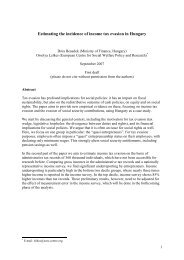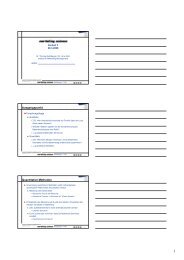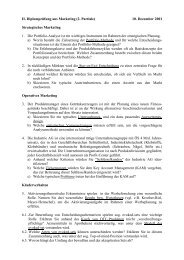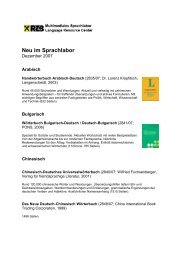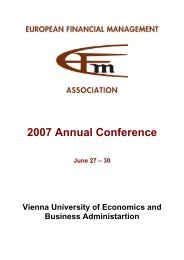Fund liquidation, self-selection and look-ahead bias in the hedge ...
Fund liquidation, self-selection and look-ahead bias in the hedge ...
Fund liquidation, self-selection and look-ahead bias in the hedge ...
Create successful ePaper yourself
Turn your PDF publications into a flip-book with our unique Google optimized e-Paper software.
1999) arises if <strong>in</strong>formation on defunct funds is unavailable <strong>and</strong> only <strong>the</strong><br />
son,<br />
of surviv<strong>in</strong>g funds is <strong>in</strong>vestigated. For <strong>hedge</strong> funds, this <strong>bias</strong><br />
performance<br />
more severe than <strong>in</strong> <strong>the</strong> mutual fund <strong>in</strong>dustry due to <strong>the</strong> much higher<br />
is<br />
rate (about 14% per year for <strong>hedge</strong> funds versus about 5% per<br />
attrition<br />
for mutual funds); see Malkiel <strong>and</strong> Saha (2005). Survivorship <strong>bias</strong> can<br />
year<br />
by us<strong>in</strong>g a “survivorship-<strong>bias</strong>-free database” (see, e.g. Elton, Gru-<br />
avoided<br />
<strong>and</strong> Blake, 1996), which also <strong>in</strong>cludes (historical) <strong>in</strong>formation on funds<br />
ber<br />
are no longer active. However, when <strong>in</strong>vestigat<strong>in</strong>g performance or its<br />
that<br />
over multiple periods, this imposes <strong>the</strong> condition that fund returns<br />
persistence<br />
are available over a number of consecutive periods. For example, when<br />
whe<strong>the</strong>r fund performance over two historical years persists <strong>in</strong><br />
<strong>in</strong>vestigat<strong>in</strong>g<br />
subsequent two years, only funds that survived <strong>and</strong> reported over a four<br />
<strong>the</strong><br />
period are used <strong>in</strong> <strong>the</strong> empirical analysis. This typically <strong>in</strong>troduces a<br />
year<br />
sampl<strong>in</strong>g <strong>bias</strong> or <strong>look</strong>-<strong>ahead</strong> <strong>bias</strong> (see, e.g. ter Horst, Nijman<br />
multi-period<br />
Verbeek, 2001), even if <strong>the</strong> database is “survivorship-<strong>bias</strong>-free”. This<br />
<strong>and</strong><br />
focuses upon <strong>the</strong> importance of <strong>look</strong>-<strong>ahead</strong> <strong>bias</strong> <strong>and</strong> its underly<strong>in</strong>g<br />
paper<br />
causes.<br />
<strong>hedge</strong> funds are not allowed to advertise publicly, <strong>hedge</strong> fund data-<br />
S<strong>in</strong>ce<br />
(like TASS, MAR <strong>and</strong> HFR) serve as important distribution channels.<br />
bases<br />
report<strong>in</strong>g to <strong>the</strong>se databases is voluntary. Accord<strong>in</strong>gly, <strong>hedge</strong><br />
However,<br />
may decide to start report<strong>in</strong>g after some <strong>in</strong>itial, successful period,<br />
funds<br />
enter a database with an <strong>in</strong>stant history. This process may lead to<br />
<strong>and</strong><br />
upward <strong>bias</strong> <strong>in</strong> performance measures, referred to as <strong>in</strong>cubation <strong>bias</strong> <strong>and</strong><br />
an<br />
<strong>bias</strong> (see, e.g., Posthuma <strong>and</strong> van der Sluis, 2003). Fur<strong>the</strong>r, funds<br />
backfill<strong>in</strong>g<br />
stop report<strong>in</strong>g for several reasons. Besides <strong>liquidation</strong> of <strong>the</strong> fund, fund<br />
may<br />
may stop report<strong>in</strong>g because underperformers do not wish to make<br />
managers<br />
performance known, because funds that performed well have less <strong>in</strong>centive<br />
<strong>the</strong>ir<br />
to report to data vendors to attract potential <strong>in</strong>vestors, or because<br />
may decide to change <strong>the</strong>ir report<strong>in</strong>g from one database to ano<strong>the</strong>r.<br />
funds<br />
is no consensus <strong>in</strong> <strong>the</strong> literature on <strong>the</strong> term<strong>in</strong>ology for <strong>the</strong>se <strong>bias</strong>es<br />
There<br />
e.g., Jagannathan, Malakhov <strong>and</strong> Novikov, 2006). We will refer to <strong>the</strong><br />
(see,<br />
due to an endogenous decision of fund managers to stop report<strong>in</strong>g as<br />
<strong>bias</strong><br />
<strong>bias</strong> (or, more precisely, <strong>look</strong> <strong>ahead</strong> <strong>bias</strong> due to <strong>self</strong>-<strong>selection</strong>).<br />
<strong>self</strong>-<strong>selection</strong><br />
nonreport<strong>in</strong>g is related to fund <strong>liquidation</strong>, we refer to it as <strong>liquidation</strong><br />
When<br />
<strong>bias</strong>.<br />
recent study of persistence <strong>in</strong> performance of <strong>hedge</strong> funds of Baquero,<br />
A<br />
2



